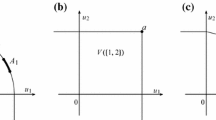Abstract
We introduce a two-sided market situation with a central player. This player plays both the role of buyer and seller. From this situation we consider the corresponding TU-game and describe the core of the game in terms of the market data. We also study two point solutions: the nucleolus and the \(\tau \)-value. When we allow the central player to have multiple partners, the game is still balanced and each competitive equilibrium provides a core allocation.
Similar content being viewed by others
Notes
For technical reasons, we will consider, if necessary, that in case of only one seller we can assume a fictious seller with \(a_{2h}=0\), and similarly, a fictious second buyer with \(a_{h2}=0\) in case of only one buyer.
References
Arin J, Feltkamp V (1997) The nucleolus of veto-rich transferable utility games. Int J Game Theory 26:61–73
Aumann R (1985) What Is game theory trying to accomplish? In: Arrow K, Honkapohja S (eds) Frontiers of economics. Basil Blackwell, Oxford, pp 5–46
Bahel E (2016) On the core and bargaining set of a veto game. Int J Game Theory 45:543–566
Bahel E (2018) On the properties of the nucleolus of a veto game. Econ Bull. https://doi.org/10.1007/s40505-018-0155-6
Gale D (1960) The theory of linear economic models. McGraw Hill, New York
Huberman G (1980) The nucleolus and essential coalitions, In: A Bensoussan, JL Lions (eds) Analysis and optimization of systems, vol 28 of Lecture Notes in Control and Information Sciences. Elsevier B.V, pp 416–422
Izquierdo J, Núñez M, Rafels C (2007) A simple procedure to obtain the extreme core allocations of an assignment market. Int J Game Theory 36:17–26
Johri A, Leach J (2002) Middlemen and the allocation of heterogeneous goods. Int Econ Rev 43:347–361
Kaneko M (1983) Housing markets with indivisibilities. J Urb Econ 13:22–50
Kaneko M, Wooders M (1982) Cores of partitioning games. Math Soc Sci 3:313–327
Núñez M, Rafels C (2003) Characterization of the extreme core allocations of the assignament game. Games Econ Behav 44:311–331
Núñez M, Rafels C (2013) Von Neumann-Morgenstern solutions in the assignment market. J Econ Theory 148:1282–1291
Oishi T, Sakaue S (2014) Middlemen in the Shapley-Shubik competitive markets for indivisible goods. Math Econ Lett 2(1–2):19–26
Sánchez-Soriano J, López M, García-Jurado I (2001) On the core of transportation games. Math Soc Sci 41:215–225
Shapley L (1971) Cores of convex games. Int J Game Theory 1:11–26
Shapley L, Shubik M (1972) The assignment game I: the core. Int J Game Theory 1:111–130
Solymosi T (1999) On the bargaining set, kernel and core of superadditive games. Int J Game Theory 28:229–240
Stuart H (1997) The supplier-firm-buyer game and its m-sided generalization. Math Soc Sci 34:21–27
Tejada O, Borm P, Lohmann E (2014) A unifying model for matrix-based pairing situations. Math Soc Sci 72:55–61
Acknowledgements
We gratefully thank Marina Núñez and two anonymous referees for their suggestions, especially, the idea given by an anonymous referee to improve the characterization of the nucleolus of assignment games with a central player. The authors also acknowledge the support from the research grant ECO2017-86481-P (Ministerio de Economía y Competitividad).
Author information
Authors and Affiliations
Corresponding author
Additional information
Publisher's Note
Springer Nature remains neutral with regard to jurisdictional claims in published maps and institutional affiliations.
Rights and permissions
About this article
Cite this article
El Obadi, S., Miquel, S. Assignment Games with a Central Player. Group Decis Negot 28, 1129–1148 (2019). https://doi.org/10.1007/s10726-019-09638-1
Published:
Issue Date:
DOI: https://doi.org/10.1007/s10726-019-09638-1




